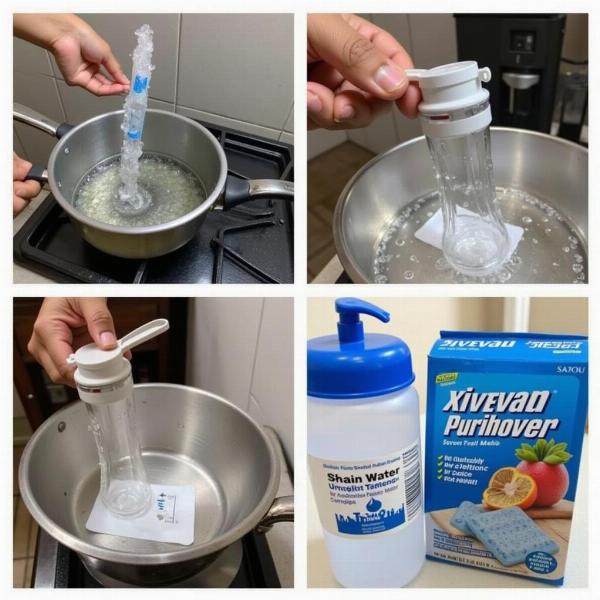Raw water meaning in Hindi revolves around the concept of untreated water, water in its natural state, untouched by human intervention. This includes water from sources like rivers, lakes, springs, and groundwater before any treatment or purification process. Understanding the meaning and implications of using raw water is crucial, especially in a context like India where access to clean and safe drinking water can be a challenge.
What Does “Raw Water” Translate to in Hindi?
“Raw water” doesn’t have a single, direct equivalent in Hindi. Instead, several terms can be used depending on the specific context. Common translations include:
- कच्चा पानी (Kachcha Paani): This literally translates to “raw water” and is the most commonly used term. It generally refers to water that is untreated and unsuitable for drinking.
- अशुद्ध जल (Ashuddh Jal): This translates to “impure water” and emphasizes the water’s contaminated state.
- प्राकृतिक जल (Prakritik Jal): Meaning “natural water”, this term refers to water in its natural state, found in sources like rivers and lakes. However, it doesn’t necessarily imply that the water is unsafe.
- बिना उपचारित जल (Bina Upchaarit Jal): This translates to “untreated water” and clearly indicates the lack of any purification process.
The Risks of Consuming Raw Water
While some advocate for the supposed health benefits of raw water, consuming untreated water poses significant health risks due to potential contaminants:
- Bacteria and Viruses: Raw water can harbor harmful bacteria like E. coli and viruses that cause diseases like cholera and typhoid.
- Parasites: Parasites such as Giardia and Cryptosporidium can contaminate raw water, leading to gastrointestinal illnesses.
- Chemicals: Industrial runoff and agricultural pesticides can contaminate raw water sources, posing long-term health risks.
- Heavy Metals: Raw water can contain heavy metals like lead and arsenic, which can accumulate in the body and cause various health problems.
 Water Purification Methods
Water Purification Methods
Why is Understanding “Raw Water” Important in India?
Understanding the implications of “raw water” is especially crucial in India due to the widespread reliance on natural water sources and the ongoing challenges in providing access to safe drinking water for all. Many rural communities rely on wells, rivers, and ponds for their daily water needs, making them vulnerable to waterborne diseases if the water isn’t treated properly.
How to Make Raw Water Safe for Drinking
Several methods can be used to purify raw water and make it safe for consumption:
- Boiling: Boiling water for at least one minute kills most harmful bacteria and viruses.
- Water Filters: Various types of water filters, including ceramic, carbon, and reverse osmosis filters, can remove contaminants from raw water.
- Water Purification Tablets: These tablets contain chemicals that disinfect water and kill harmful microorganisms.
- UV Sterilization: UV light can effectively kill bacteria and viruses in raw water.
Raw Water vs. Treated Water: A Crucial Distinction
The difference between raw water and treated water lies in the purification process. Raw water is in its natural state, while treated water has undergone processes to remove contaminants and make it safe for consumption. This distinction is fundamental for public health and well-being.
Conclusion
Understanding “raw water meaning in Hindi” is essential for promoting safe water practices and ensuring public health. While natural water sources are vital, consuming untreated water carries significant health risks. By utilizing appropriate purification methods, we can ensure access to safe and healthy drinking water for everyone.
FAQ
- Is it safe to drink raw water directly from a natural source? No, drinking raw water directly from a natural source is unsafe due to potential contamination.
- What are the most common methods for purifying raw water in India? Boiling, water filters, and water purification tablets are common methods for purifying raw water in India.
- What are the health risks associated with consuming raw water? Consuming raw water can lead to bacterial, viral, and parasitic infections, as well as exposure to harmful chemicals and heavy metals.
- What is the meaning of “kachcha paani” in Hindi? “Kachcha paani” generally refers to raw or untreated water unsuitable for drinking.
- What does “ashuddh jal” mean in Hindi? “Ashuddh jal” translates to impure water.
- Why is access to safe drinking water a concern in India? Access to safe drinking water remains a challenge in India, particularly in rural areas, due to reliance on untreated water sources and limited access to purification methods.
- What is the difference between “prakritik jal” and “bina upchaarit jal”? While both refer to water in its natural state, “bina upchaarit jal” specifically emphasizes the lack of treatment, highlighting potential risks.
Related Articles
Meaning-Hindi.in is a leading provider of Hindi translation services, catering to diverse needs from business and legal documents to technical manuals and website localization. We offer expert translation in various specialized fields, including business & commerce, legal & certified, technical & manuals, website & localization, education & academic, express & urgent, and specialized industry translations. For high-quality, reliable Hindi translations, contact us at [email protected] or call +91 11-4502-7584. Meaning-Hindi.in – your trusted partner for accurate and culturally sensitive Hindi translations.